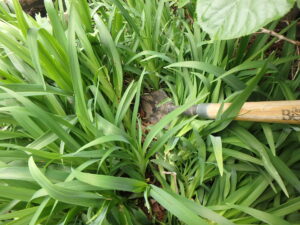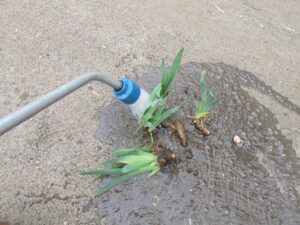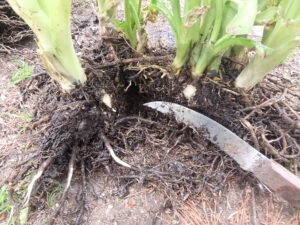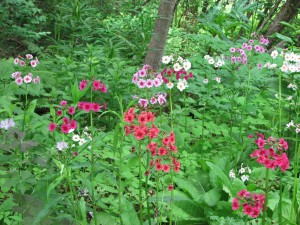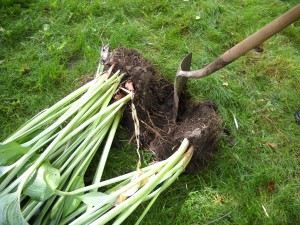How to Divide Flowers to Get More Plants – for Free!
Another way to learn about dividing plants is to just do it. Dig up a plant and examine the roots. I use a drain spade to do this. A drain spade is a pointed shovel with a long, narrow blade (commonly 6 inches wide and 16 inches long). I plunge it into the soil and pry back a little. Then I repeat the procedure on all sides. When the plant is loose, I lift it out.
When dividing a plant, you may wish to actually bare-root it. Do this by shaking off any soil attached, or washing the root system with a hose to remove the soil. Weed or grass roots will be obvious when you do that. I normally do that for any gifted plants because I want to avoid getting any invasive weeds that might come with it. I learned that lesson the hard way, having accepted some nice iris plants that had goutweed roots embedded that then have plagued me for 30 years.
I was dividing some hostas recently, and found some clumps hard to pull apart. So I used a curved, serrated knife to cut through some roots, allowing me to separate them. If you don’t have a garden knife, buy a steak knife at a yard sale or junk shop – on sneak one out of the kitchen – and it will work just fine.
Saving Money in the Flower Garden
My house sits on a couple of acres, most of which is growing something. There is a big vegetable garden, some trees, berry bushes and decorative shrubs, a little lawn and lots of flowers. I could spend a fortune, I suppose, if I bought flowers for every square foot of flowerbed that I have. Over the years, however, I have learned how to transplant small plants that started on their own from seed – “volunteers” – and how to divide existing perennials.
Let’s start with the volunteer plants. The first thing one must do is learn to recognize the young seedlings – and not pull them as weeds. I do this mainly by the color and texture of the leaves, but shape is important, too. And of course, you can’t use bark mulch in the flower beds if you want volunteers. I grow perennials close together so that they shade out weeds, and try to pull any weeds that do grow before the go to seed.
Twenty years ago a neighbor pulled up in front of my house and handed me a cardboard box with 8 candelabra primroses (Primula japonica). I accepted them with pleasure, and went directly to a good reference book to find out what they needed: rich soil, light shade, consistent moisture. I had those conditions under a small grove of wild apple trees, and planted them there.
Now I have hundreds of candelabra primroses and many other kinds. Once I realized that one primrose would grow there, I tried other species, and all but one (P. vialii) have done well there – and spread. Most spread by seed, and one (P. kisona) by root, like a groundcover. I regularly dig primroses and move them or give them to friends.
Giving excess plants to friends, especially lesser known varieties, is a great way to save money. I find that if you give a person a nice clump of flowers, you are most certainly going to go home with 2 or 3 new plants for your own garden.
Dividing plants is easy, once you get the hang of it. But you have to know what kind of root each perennial has, and that generally means some experimentation. The only book I have found that describes dividing for most common perennials is The Well-Tended Perennial Garden: Planting & Pruning Techniques by Tracy DiSabato-Aust. That’s a book that should be in every gardener’s library because it tells you how to prune, deadhead, get to re-bloom, divide and more. It’s in hardback at $34.95 (Timber Press, 2006) and worth every penny.
It is best to divide most perennials in the spring when the foliage is just 3-6 inches tall. Tough characters like hostas and daylilies can be done anytime, though preferably on a cool cloudy day if doing so now. I recently divided a few hostas and took off a section from a large bugbane or snakeroot (Cimicifuga ramosa), and none showed signs of stress.
You can cut out a section of a large hosta or daylily by cutting out a wedge with a spade or even a long knife. I sometimes use a serrated root knife I got from Lee Valley Tools. Tracy DiSabato-Aust prefers a non-serrated knife, so I guess either will work just fine. Get down on your hands and knees and try to see natural division points before you cut.
Alternatively, you can dig up a plant, place it on the ground and then use 2 spading forks to separate it. Just insert them into the middle of the clump, back-to-back, and work the forks back and forth. It’s a lot of work for a big clump of daylilies. I prefer just to cut up a clump with a sharp spade. The spade lets me stand on it with all my weight to slice through the tough roots. I once divided a 4-foot wide clump of Joe Pye weed (Eupatorium maculatum) and ended up using a pick ax to whack it apart. Not a pretty sight, but I was determined to remove and divide it.
Groundcovers send out roots and can be divided anytime. Just dig up a plant, sever the root from the mother plant, and move it to a new location. Easy.
Some plants have fleshy taproots that are easily broken, and these are not good candidates for division. Peonies, Oriental poppies, bleeding heart and pink mallow fit in that category. They should be divided in the fall –though little seedlings move easily, spring or fall. Siberian iris should be divided in fall.
Some plants go downhill and become less vigorous if they are not divided on a regular basis. Have you lost a nice Shasta daisy? If so, please try again – but divide it every 3 years. That allows you to add compost and slow-release organic fertilizer to the soil, which rejuvenates the plants.
The easiest, least expensive method for getting more flowers is just to save seeds and plant them. I plant when the seeds are ripe, just scratching them in where I want more plants next year. I do this with Jack-in-the-pulpit, annual poppies, foxgloves and rose campion, and they generally reward me handsomely.
So don’t spend a fortune. Divide, trade with friends, start things by seed. In no time you’ll have all the plants you need – even if not all the plants you want.
Henry Homeyer is the author of 4 gardening books. His Web site is www.Gardening-Guy.com.



